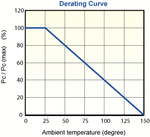Follow along with the video below to see how to install our site as a web app on your home screen.
Note: This feature may not be available in some browsers.

No, a device that can flow 2.2 watts of heat per degree, can get rid of more heat than a device that can only flow 0.5 watts per degree temperature difference.Is that mean the less the derating factor the more the device can dissipate power and heat. for instance factor 0.5 W/c is better than 2.2 w/c